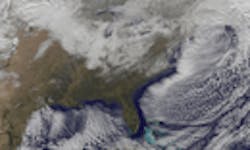Massive Nor’easter snowstorm forces road closures as it tracks north
A powerful snowstorm that developed in the Southeast and is now in its third day is leaving road closures and snarled traffic in its wake as it tracks north today into New England, where Boston is experiencing blizzard conditions.
Even 48 hours after the storm barreled through Albany in southwestern Georgia, a report posted this morning on local TV news station WALB Channel 10 stated “the remnants of the storm are still affecting travel. That's hurting some businesses in south Georgia. Operations at area trucking companies slowed down tremendously because many drivers simply can't get where they need to go.”
The report went on to note that Atlanta highways are still backed up as well. “And that means anything from tires to clothes to chemicals aren't getting to their suppliers,” wrote reporter Cade Fowler. “One stranded trucker on 285 was hauling cattle. ‘I was in Minnesota last week [Fowler reported]. It was worse than this and I went in and came out.’”
The reporter noted the livestock driver is concerned that if stranded any longer, his load might not survive. “ If what you need is in a tractor trailer, you're pretty much out of luck right now,” Fowler added. “Thick ice on Interstate 285 and other Atlanta area interstates brought hundreds of rigs to a stand still.”
It’s much the same story straight up the East Coast, as the storm came out of Georgia and began steaming northeast hugging the coast. The heavy snows it dumped along the way put at least 10 states under winter weather alerts, from Delaware and Maryland out to Pennsylvania and up into coastal New Jersey and the New York City metro area and on into Connecticut, Rhode Island, Massachusetts, Maine and New Hampshire.
According to the weather.com website of The Weather Channel, the “heaviest snow swath will be about 50-100 miles east of the Christmas [blizzard] snow swath”… from New York State’s Long Island to Connecticut, Massachusetts, southern Vermont and southern New Hampshire.
Weather.com puts likely total storm accumulations at “well over a foot” for southern New England southward into Long Island—with local amounts over 20 in. possible.
The website stated sternly that today “Roads will become impassible over parts of CT, MA, RI, southern VT, and southern NH!”
The report added that “Blizzard conditions may occur, at times, much of Wednesday before slowly winding down Thursday in coastal New England and parts of Long Island.” Weather.com also noted that on the “interior side” that “moderate, but disruptive amounts of snow will pile up in the eastern Great Lakes, with higher amounts in the lake snowbelts, which will see lake-enhanced snowfall over 6".” Island.
Acting ahead of the storm, several state Governors including two newly installed first-termers-- Andrew Cuomo (D-NY) and Dannell Malloy (D-CT) --issued detailed preparatory orders in hopes their states would not be caught flat-footed the way New York City was by the now infamous December 26th storm that paralyzed the Big Apple just 17 days ago.
The governors also urged motorists to stay home once the storm hit their area so that road crews would have a much easier and faster time of clearing highways and major roads. Nonetheless, reports of road closures due either to blinding snow or accidents blocking travel lanes—and those usually involving tractor-trailers—have come steadily along with the storm’s northern progress.
The New York State Dept. of Transportation (NYDOT) issued a special plea to motorists to use caution when driving near highway snowplows-- noting that these trucks travel at about 35 mph to properly disperse salt and other [de-icing] preparations on the roads.
“Snowplow drivers have limited visibility, so motorists and pedestrians should never assume a snowplow driver can see them,” stated NYDOT. “The size and weight of snowplows make it very difficult to maneuver and stop quickly. Blowing snow from plows can severely reduce visibility. The safest place for motorists is well behind the snowplows where the roadway is clear and salted. Motorists should not attempt to pass plows or follow too closely.”
This afternoon the storm is hitting Boston and blizzard conditions are being reported there by local media.
